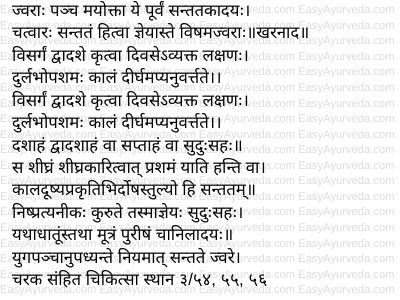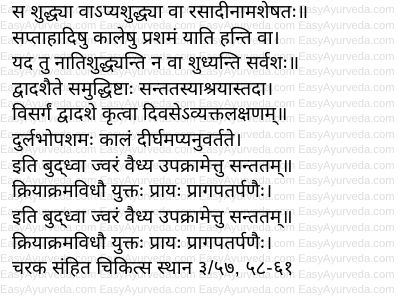Continuous fever: Santata Jwara Pathogenesis, Treatment
By Dr Raghuram Y.S. MD (Ay) & Dr Manasa, B.A.M.S
Santata Jwara is one among the five types of vishama jwara – irregular fevers explained in Ayurveda. All irregular fevers should satisfy the below mentioned conditions.
The fevers should have –
Abrupt onset – sometimes from the head, sometimes from the back etc
Abnormal activity – sometimes associated with severe cold and sometimes with excessive rise in temperature.
Uneven distribution of the duration of fever – the time and attacks of fevers is abrupt, bouts of fever may occur before or after the expected time and day. Similarly the fever may persist for either short or longer duration.

Table of Contents
Definition
‘The fever which appears once again after periods of remission is called vishama jwara’. (Madhukosha commentary, Madhava Nidana)
But this definition cannot be accepted since santata type of irregular fever does not follow this rule. Then santata will not be considered as irregular fever. Santata fever persists all time. There is no period of remission in santata fever.
Read – Jwara Pravritti – The Initial Manifestation
Is Santata fever a regular or irregular fever – reasons and clarifications!
Master Kharanada has exempted santata fever and has considered the other 4 types of fevers as irregular fevers.
Therefore, according to Kharanada, satata, anyedhyushka, tritiyaka and chaturtaka are the 4 types of irregular fevers while santata isn’t. Some opine that ‘even santata fever has periods of remission and appearance i.e. the fever subsides and comes back as in other type of irregular fevers’.
We can get a clarification of this opinion from the explanation of Master Charaka –
The santata fever sometimes comes down for a very short duration (remission may not even come to our notice) and once again increases, only to persist for longer duration. Since there is a small remission, santata fever too can be considered to be an irregular fever.
Master Kharanada has not considered santata fever as irregular fever since he wanted to differentiate them from the other irregular fevers from the perspective of symptoms and for convenience of treatment. There is also a possibility that he has not considered the ‘very short and subtle remission of santata fever’ as being irregular. Example, eating one morsel or grain of rice while fasting is not considered as ‘having food’.
Read – Causes, Symptoms, Treatment Of Recurring Fevers Punaravartaka Jwara
This explanation points towards santata not being an irregular fever as it doesn’t show clear remission like the other irregular fevers.
Vishama and Sama Jwara – The term vishama i.e. irregular fevers also tells us that there are fevers which are opposite in nature to these fevers, which are sama i.e. regular fevers. Since santata fever is always present and has almost negligible remission it is better to consider this fever as regular fever. This is another reason which substantiates that santata fever shall not be considered as irregular fever. It is also logical that while counting the irregular fevers, the authors have first mentioned santata fever i.e. regular fever and then have enlisted 4 kinds of irregular fevers i.e. satata, anyedhyushka, tritiyaka and chaturthaka fevers.
But logically and theoretically authors and grand masters of Ayurveda have not clearly declared santata fever as regular fever. It has been counted among the irregular fevers. Therefore it is wise enough to consider it as an irregular fever.
It also makes sense to accept Master Vagbhata’s definition of irregular fevers.
Read – Ayurveda Lifestyle and Diet For Fever – 45 Important Things To Know
Pathogenesis
The doshas spread all through the body while getting scattered in the rasa carrying channels. In this case the entire body becomes rigid and stiff. These events lead to the manifestation of santata fever.
Nature, periodicity and prognosis of santata fever on the basis of doshas involved
Santata fever is a very difficult condition and will also cause death in quick time. The duration of fever depends on the main dosha causing santata fever.
Following the doshas involved, santata fever either –
– gets pacified within 7 days (vata), 10 days (pitta) or 12 days (kapha) due to decrease in doshas or
– causes death within 7 days (vata), 10 days (pitta) or 12 days (kapha) due to aggravation of doshas
| Irregular Fever | Effect | ||
| Santat Jwar | Gets pacified | Causes death | Within |
| Vata Predominant | When vata gets pacified | When vata gets aggravated | 7 days |
| Pitta Predominant | When pitta gets pacified | When pitta gets aggravated | 10 days |
| Kapha Predominant | When kapha gets pacified | When kapha gets aggravated | 12 days |
Read – Use Of Herbal Decoctions In Fever -Kashaya In Jwara
Incurable
The doshas having the season, tissue and constitution of the person similar to them and have no opposing / antagonizing factors cause santata fevers. Therefore they are either incurable or curable with great difficulty.
Sites
In santata fever the vitiated doshas contaminate all the tissues, feces and urine. Therefore there are 12 components / seats of the body which are contaminated and involved in the pathogenesis of santata fever.
| Components involved in the causation of santata fever | |||
| Sl No | Doshas | Tissues | Excreta |
| 1 | Vata | Lymph / Plasma | Feces |
| 2 | Pitta | Blood | Urine |
| 3 | Kapha | Muscles | |
| 4 | Fat | ||
| 5 | Bones | ||
| 6 | Bone Marrow | ||
| 7 | Semen |
Prognosis on the basis of tissues involved in the pathogenesis of santata fevers
Vata, Pitta and Kapha types of santata fever gets –
– pacified in 7, 10 and 12 days respectively if the tissues are thoroughly cleansed and purified (by administering cleansing therapies) or
– causes death in 7, 10 and 12 days respectively if the tissues remain contaminated by the doshas / not at all cleansed
What if the tissues are partially cleansed and partially remain contaminated?
The fever will go away on the 12th day when –
– the tissues are not purified entirely i.e. each tissue is partially contaminated and partially purified or
– when the 12 components of santata fever are not totally purified or
– among these 12 components some are purified and some are contaminated
In spite of remission of fever its symptoms remain latent always. This means to tell that the fever gets latent inside the body and its symptoms are not evident. Following this, the fever once again clearly surfaces on the 13th day. The time of pacification of this fever will be unclear. This fever will run for many days and months.
Read – Use Of Water In Fever, Rules, Method, Ayurveda Perspective
Sanskrit Verses


Treatment principles
The physician should treat the santata type of fever skillfully after having considered the etiological factors and symptoms thoroughly. Depleting / lightening therapies will be the main line of treatment of santata fever. Without understanding the nature of this fever, the character of the doshas involved, the tissues involved in the pathology, the seasons and time duration related to the fever and the constitution of the patient, santata fever cannot be treated successfully.
Formulations from Sahasra Yoga Text Book
Jirna Jwarahara Kashaya
Click to Consult Dr Raghuram Y.S. MD (Ayu)








